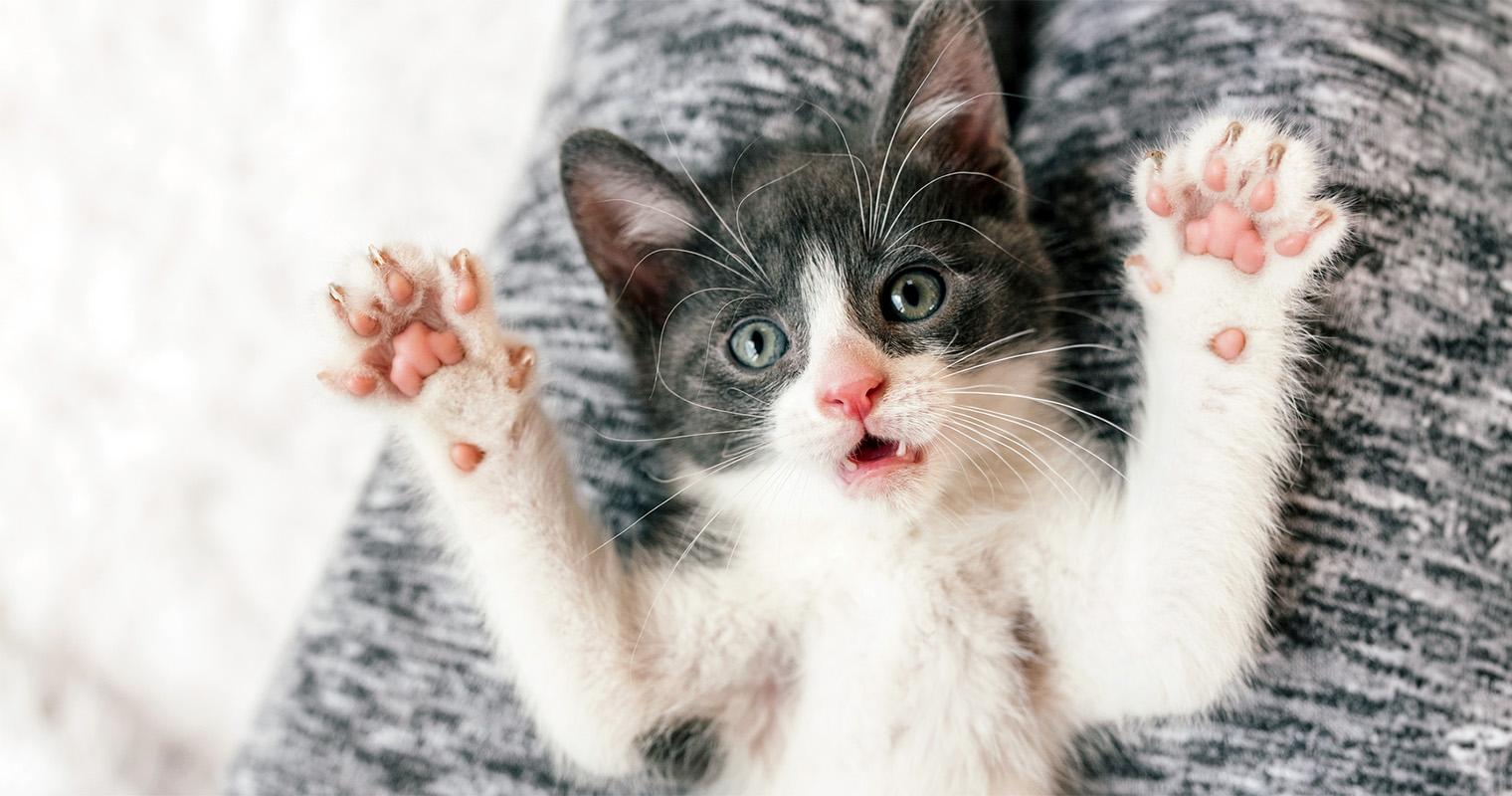Declawing Cats: Is Declawing A Cat Harmful?
Uncover the truth behind this practice and its impact on feline well-being.
Uncover the truth behind this practice and its impact on feline well-being.
by Adrienne A. Kruzer, BBA, RVT, LVT, | March 18, 2024

Melanie DeFazio / Stocksy
Despite some countries banning declawing, prevailing myths assuming they’re simple nail “trims” persist, dismissing long-term mobility complications plus resulting behavioral and health troubles. Instead of declawing, pet parents can train cats by redirecting scratching onto appropriate surfaces. Once cat parents understand what declawing is, they are more likely to understand why it is no longer routinely recommended by veterinarians.
Declawing a cat is not the same thing as a nail trim. Declawing is a surgical procedure that permanently removes not only the nail but also the bone that the nail grows out of. A nail trim is a temporary cutting of the claw that is made of keratin that continuously grows throughout the life of a cat. The technical name of a declaw is an “onychectomy,” and it is a toe amputation.
When the tip of the toe is removed in this procedure, the joint space in between the last two bones of the toe is cut, the last bone of the toe that the nail grows out of is removed, and the skin is closed over the remaining bone with sutures or surgical glue. Historically, this surgical procedure was seen as a simple solution for cats scratching furniture or other surfaces but due to the permanent negative effects it causes, this amputation is not a common recommendation anymore. There are much better cat scratch solutions than declawing cats.
Declawing a cat is harmful for a variety of physical and psychological reasons. Do vets still declaw cats even though the procedure is harmful? Some do, yes, but many are no longer performing this surgery unless it is medically necessary. But is it illegal to declaw cats? Despite the harm it causes, it is not illegal to declaw cats everywhere, at least not yet.
The importance and awareness of feline behavioral health has grown over the years and has resulted in more information on what feline anxiety, fear, pain and stress looks like. Because of this information, it is now easier to recognize the harm that declawing a cat causes and provide valid reasons against having the procedure performed. Declawing is no longer one of the solutions for cat scratching because of this recognizable harm. If you’re somehow still asking yourself, “Does declawing a cat hurt them?” think about the following types of harm declawing causes:
There are a number of ways declawing causes physical harm to a cat. Some types of physical harm caused by declawing include:
Bone removal: This is the obvious type of physical harm that results from a declawing procedure. The last bone of the toe is cut off during a declaw causing physical harm to a cat’s foot.
Medical complications: Since declawing is a surgical procedure, there is always a risk of a cat developing an infection, abnormal bleeding, wounds opening up, or having bone be left behind. More than half of all declawed cats are likely to have bone fragments left behind from a declaw that can result in nail regrowth, paralysis, inflammation, and chronic pain. Additionally, the digital flexor tendon is negatively affected by a declaw procedure and could even cause chronic issues, including lameness, over time.
Pain: Cat parents may assume that a cat doesn’t feel any pain when they are anesthetized, but if appropriate pain control is not provided before, during, and after the procedure, an amputation of any kind can cause permanent pain. Declaws are especially painful because a cat walks on the incisions every day. The chronic pain from declawing can result in over-grooming in an attempt to soothe the pain, an aversion to painful clay and crystal litter, and potentially even aggression from the chronic pain. Phantom pains may also be present in declawed cats like they are in human amputees.
Abnormal gait: It’s no surprise that cats use their feet to walk and the bones in their toes are important parts of a cat’s normal gait. If part of your cat’s toes are missing, they will bear weight unnaturally which can result in inflammation and painful orthopedic issues.
Instability: Cats use their claws to climb, grip and balance. If they don’t have these parts of their body to help them feel stable and safe, they may become stressed, fearful, or even become physically injured.
Anxiety: The physical pain declawing causes can result in a cat having severe anxiety. They’ll get anxious about being unable to do normal cat things such as climbing and marking with their nails. If they have chronic pain from a declaw, they may be anxious to do things that exacerbate this pain, such as put weight on their paws, scratch in a litter box, or do other normal cat things.
Fear: A declawed cat may develop an unhealthy level of fear if they are unable to defend itself, escape, or balance due to not having claws. Fearful cats can become biting cats.
Stress: Anxious and fearful cats can also become stressed cats and stress causes unwanted behaviors and medical issues. Stressful cats with constant anxiety may exhibit symptoms of anxiety like eliminating outside the litter box and over-grooming.
Unnecessary harm: Sometimes surgery is necessary to alleviate pain or correct an abnormality, but when it is done for cosmetic or other non-medical reasons, it may be considered unethical. If performed to simply prevent a cat from scratching, declawing is considered to be an unethical practice by many.
Thankfully there are a few solutions for cat scratching that don’t involve cutting off your cat’s toes.
Nail caps: Small vinyl nail covers can be glued over your cat’s claws. These will need to be replaced on a regular basis as your cat’s nails grow, but they are not painful and help prevent your cat’s nails from damaging surfaces. If your cat is demonstrating signs of psychological harm due to these protective caps though, discontinue use.
Nail trims: Regularly trimming your cat’s nails decreases the amount of damage they can do to your skin and other surfaces. Nail trims can be done every four to six weeks to keep them short.
Scratching posts: Provide appropriate scratching surfaces for your cat to use. It is normal for cats to scratch things, so if you give them posts and pads with enticing surfaces, they are more likely to scratch these items over things you don’t want them to scratch.
Redirection and removal: In addition to providing appropriate things to scratch, you may be able to redirect them to these items by playing with them near the posts, sprinkling catnip on them, and giving them praise when they scratch what you want them to. You might also be able to remove or hide some items your cat enjoys scratching, such as baskets and ottomans, to force your cat to find something else to claw.
Pheromones: You can buy sprays, wipes, and diffusers to help your cat feel as though there is no need to mark their territory by scratching. These pheromones can not be smelled by humans, but they can be smelled by cats.
Cat-proofing your home means hiding, removing, or securing things that can harm your cat. It also helps prevent your cat from damaging things by scratching.
Instead of declawing, you can train your cat to stop scratching what they shouldn’t by providing them with appropriate scratching surfaces, giving praise when they scratch what they should, removing things you don’t want them to scratch whenever possible, utilizing pheromones, and redirecting their attention to the things you want them to scratch.
Training can take a little time but be sure to avoid yelling, hitting, and spraying your cat with water to get your point across as these are ineffective training methods. Consistency is key, but keep in mind that the goal is not to stop your cat from scratching all together.
Pain and Adverse Behavior in Declawed Cats
Human Health Concerns in Anti-Declaw Laws
SB67: Animal Welfare - Declawing Cats - Prohibited Acts
The Humane Society of the United States: “Keeping Your Cat Stress-Free”

Adrienne Kruzer is an accomplished veterinary technician and writer with over 15 years of hands-on experience caring for domestic and exotic animals.